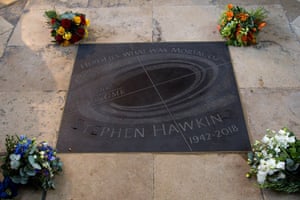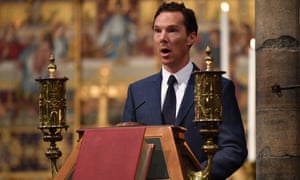Luminaries from academia and science pay tribute to the late physicist’s incredible legacy
“We remember Isaac Newton for answers,” said Prof Kip Thorne. “We remember Hawking for questions.”
For 40 years, physicists have pondered the questions raised by Prof Stephen Hawking’s work, and perhaps his greatest legacy is not his remarkable discoveries, but the impact of his work on future theories of physics. Thorne, a Nobel prize-winning physicist, paid tribute to his friend Hawking by saying that future scientists would not stand on the shoulders of giants, as Newton had it, but “on the shoulders of Hawking”.
Hawking’s remains were buried on Friday beneath a sunlit arch, between those of Darwin and Newton, at a memorial service at Westminster Abbey.
In an example of the public affection held for Hawking – giant of science, best-selling author, pop culture icon – 27,000 people had applied to attend the event, from which 1,000 were picked. Among them were schoolchildren, and students from colleges for people with special educational needs.
“He was a great scientist,” said Jack Smith, 21, a student at National Star College in Cheltenham, before the service, speaking with the same kind of voice device used by Hawking. “He was a great role model that inspired me to use my voice,” added another student, Rose Brown, 20. “It will be sad but it is an honour to be here.”

For 40 years, physicists have pondered the questions raised by Prof Stephen Hawking’s work, and perhaps his greatest legacy is not his remarkable discoveries, but the impact of his work on future theories of physics. Thorne, a Nobel prize-winning physicist, paid tribute to his friend Hawking by saying that future scientists would not stand on the shoulders of giants, as Newton had it, but “on the shoulders of Hawking”.
Hawking’s remains were buried on Friday beneath a sunlit arch, between those of Darwin and Newton, at a memorial service at Westminster Abbey.
In an example of the public affection held for Hawking – giant of science, best-selling author, pop culture icon – 27,000 people had applied to attend the event, from which 1,000 were picked. Among them were schoolchildren, and students from colleges for people with special educational needs.
“He was a great scientist,” said Jack Smith, 21, a student at National Star College in Cheltenham, before the service, speaking with the same kind of voice device used by Hawking. “He was a great role model that inspired me to use my voice,” added another student, Rose Brown, 20. “It will be sad but it is an honour to be here.”

Benedict Cumberbatch, who played Hawking in the 2004 BBC drama, took to the Abbey’s Great Lectern to read the first lesson from the Book of Wisdom. He read it beautifully – straight-backed and sincere, not a performance. God, we were told, gave us “unerring knowledge of what exists, to know the structure of the world and the activity of the elements; the beginning and end and middle of times”. Hawking might not have agreed. “I regard the brain as a computer which will stop working when its components fail,” Hawking once said. “There is no heaven or afterlife for broken-down computers; that is a fairy story for people afraid of the dark.”
Next to Cumberbatch, a sign language interpreter enthusiastically signed “the constellations of the stars”, her face beaming, hands above her head. It was a highlight of this wonderful, inclusive thanksgiving service. A guide dog lay on the cool stone floor across the aisle.
It was Lord Rees, the astronomer royal and decades-long friend and Cambridge colleague of Hawking, who addressed the religion issue. Hawking, said Rees, was interested in “learning the mind of God”; he shared Darwin’s “agnosticism”, Rees said diplomatically, “but it’s fitting that he too should be interred in this national shrine.”

At its most affecting, this was a celebration of Hawking’s humanity. Thorne described Hawking as “by far the most stubborn friend I ever had” to a ripple of laughter. Tom Nabarro, who broke his neck in an accident in 2008, spoke of how supportive Hawking had been as Nabarro adjusted to his circumstances. “He made sure to share his love of life. Stephen showed how we should always expect the best for one another.” Nobody could have failed to have been moved when he said his son, born only hours after Hawking died in March, carried the great man’s name.
Rees spoke of Hawking’s determination after being diagnosed with the degenerative disorder amyotropic lateral sclerosis. He was told he might not live long enough to finish his PhD. “He later said ‘everything that happened afterwards was a bonus’,” said Rees. Hawking had triumphed with a “great crescendo of achievement”, but just as compelling was his description of Hawking’s home life. There was a nod to his celebrity and “razzmatazz”. Tribute was also paid to his “forceful political opinions”, most recently about the importance of protecting the NHS “for which he acknowledged he owed so much”.
And his place within science history is assured. With his work on black holes in the 70s, Rees recounted how the soon-to-be Lucasian professor of mathematics discovered “the first firm link between two overarching 20th century theories – quantum theory and Einstein’s theory of relativity”.
“Forty years later, its ramifications cause more sleepless nights than any physics paper in history,” Rees said with a smile.
Hawking’s ashes were interred to the beautiful, otherworldly sound of Westminster Abbey’s choir, watched by Hawking’s family, who laid flowers. Later, Hawking’s words, set to music by Vangelis, were beamed to the closest black hole.
With his ashes buried beneath a stone inscribed with his earth-shifting equation, we were reminded not just how radiant Hawking was but how radiant he always will be.

No comments:
Post a Comment